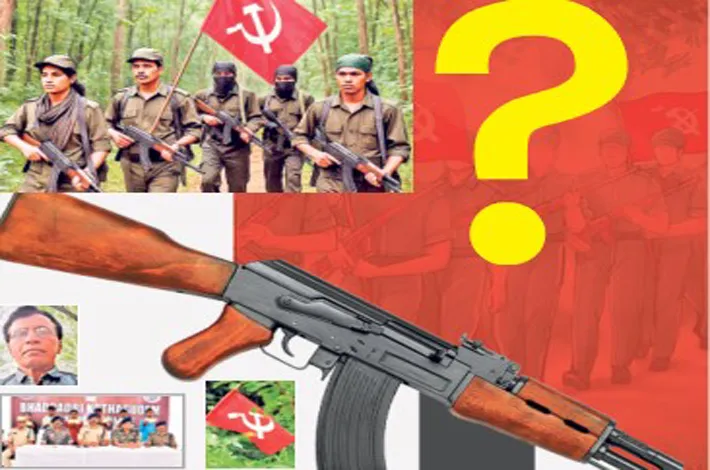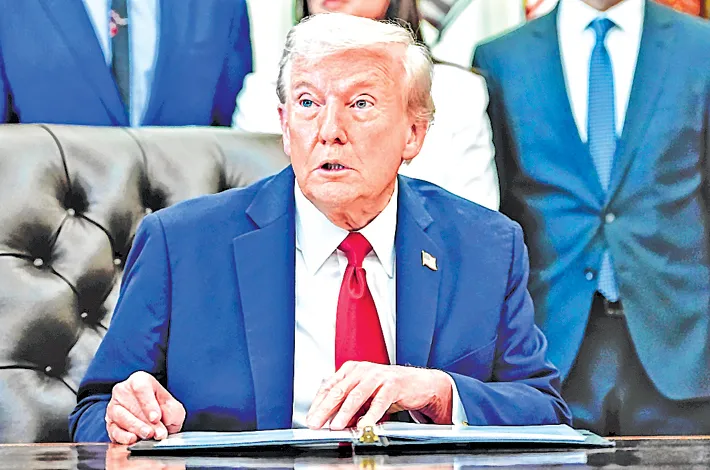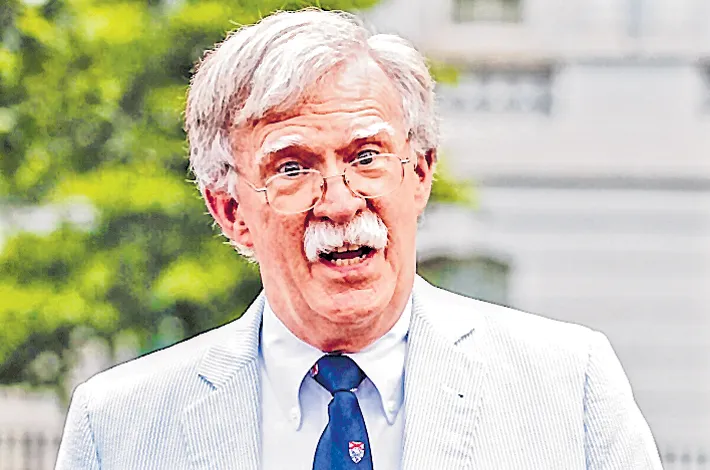Are Moaists Losing Ground
15-10-2025 12:07:59 AM

- Maoist influence has declined from 180 districts in 2006 to roughly 90 districts.
- Nearly 60 senior and mid-level cadres surrendered in Gadchiroli on Tuesday.
- Bastar region reports over 500 surrenders in the past two years.
- Youth cadre recruitment has fallen by approximately 40% over the last decade.
- Security operations recovered over 3,500 arms and explosives in 2025.
- Rehabilitation programs have engaged hundreds of former cadres in education, vocational training, and livelihood programs.
The surrender of Mallojula Venugopal Rao, popularly known as Sonu, along with nearly 60 Maoist cadres in Gadchiroli, Maharashtra, has reignited discussions about the future of the Maoist insurgency in India. Once regarded as a formidable underground movement capable of challenging the state across central and eastern India, the Communist Party of India (Maoist) now faces a confluence of pressures that threaten its survival. Mass defections, declining recruitment, internal fractures, ageing leadership, and intensified state counter-insurgency measures are combining to undermine the movement’s operational strength. Across states including Chhattisgarh, Telangana, Jharkhand, Odisha, and Maharashtra, officials report that the movement is increasingly struggling to maintain cohesion.
Yet experts caution against prematurely declaring the Maoists defeated. Persistent socio-economic grievances in tribal and marginalized areas—ranging from land dispossession to inadequate development—continue to provide the ideological soil from which insurgency can sprout.
Tracing the roots and rise of Maoism in India
Maoism in India, widely referred to as the Naxalite movement, has its origins in the late 1960s, beginning with the uprising in West Bengal’s Naxalbari region. Inspired by Mao Zedong’s vision of peasant-led revolution, small leftist groups mobilized against landlords, sought to redistribute land, and aimed to overthrow state structures through armed struggle. Over decades, fragmented factions coalesced into the Communist Party of India (Maoist) in 2004, establishing a sophisticated underground network across central and eastern India.
The movement found fertile ground in forested, tribal-dominated regions with weak state presence. Maoists capitalized on local grievances including land alienation, forced labor, poverty, and the absence of basic services. In certain pockets, they set up parallel governance structures, controlling recruitment, local taxation, dispute resolution, and resource management. At its peak during the mid-2000s, Maoist influence spanned over 180 districts across 10 states, with thousands of cadres trained in guerrilla warfare, sabotage, and ambush operations. Analysts note that the movement’s rise was facilitated not only by ideological conviction but also by the vacuum of governance, which created space for armed insurgency.
Balancing policy, security, and justice
Economic, Land, and Environmental Justice: Protect tribal land rights, consult communities before projects, safeguard water and forests, and compensate for displacement.
Healthcare and Welfare: Expand education, healthcare, sanitation, and communication access in remote areas.
Transparent Rehabilitation: Provide financial support, vocational training, mental health assistance, legal clarity, and opportunities for social reintegration.
Dialogue and Political Engagement: Negotiate with cadres willing to abandon arms, address governance policies, and create space for dissenting voices.
Youth Engagement: Invest in education, employment, and governance participation to reduce the appeal of armed movements.
Rights and Rule of Law: Ensure counter-insurgency respects human rights and deliver impartial justice.
The surge of surrenders and operational decline
By 2025, the pattern of mass surrenders has accelerated significantly, signaling potential structural erosion within the movement. This trend is not limited to lower-tier cadres; even senior operatives, regional leaders, and Politburo members are stepping away from armed struggle.
In Telangana, several seasoned cadres have abandoned the underground life, while Chhattisgarh’s Bastar region continues to witness a steady exodus. Janshi, formerly known as Vachela Matami and secretary of the Nagri Area Committee, surrendered after two decades of underground activity. She cited moral disillusionment with the movement’s persistent extortion and violence, especially targeting innocent villagers, and criticized senior cadres for exploiting juniors. “Observing the lives of those who surrendered made me question my path,” she reflected.
Similarly, lower-ranking cadres from Bastar’s Narayanpur district described the movement’s ideology as hollow, accusing leaders of coercing locals into intelligence gathering and logistical work while neglecting their welfare. In Jharkhand’s Giridih district, cadres availed themselves of state rehabilitation programs, reflecting a growing trend of non-combative exits.
Reports indicate that in 2025 alone, over 500 cadres surrendered across the Bastar region. Analysts attribute these defections to a combination of ideological fatigue, internal pressure, and the lure of state-provided rehabilitation and security incentives. Even Politburo members like Venugopal Rao have urged a strategic rethinking, writing letters to halt armed actions “to save the party,” illustrating a shift in leadership approach.
State Strategy: Security, incentives, and rehabilitation
The government’s approach combines robust security measures with attractive rehabilitation incentives. In forested tracts across Bastar, border regions, and Maharashtra, counter-insurgency operations have intensified, focusing on intelligence-driven actions and targeted operations.
Rehabilitation programs offer financial aid, vocational training, legal support, identity documentation, and assistance in family reintegration. Officials point to the surrender of senior leaders like Venugopal and the 60 cadres in Gadchiroli as evidence that the dual strategy of coercion and incentives is working. Telangana DGP B. Shivadhar Reddy described the Gadchiroli surrenders as “a major blow to the Maoist movement, indicating that even senior cadres are convinced dialogue and rehabilitation offer a safer and more constructive path forward.”
Social proof appears influential: former cadres who witness the successful reintegration of peers are more likely to surrender themselves. However, activists like Haragopal caution that security efforts must be accompanied by substantive dialogue and governance reforms. Without addressing tribal rights, resource allocation, and local governance, the cycle of conflict may persist despite tactical victories.
Perspectives from Activists and Intellectuals
Experts warn that while surrenders reduce immediate violence, they do not resolve the deeper socio-economic issues that fuel insurgency. Professor G. Haragopal, a human rights scholar, notes: “Relying solely on force risks extending repression to civil society, dissenting voices, and local communities.” He stresses that without meaningful dialogue—particularly on tribal rights, resource governance, and land disputes—surrenders alone may fail to bring long-term peace.
Writer and activist Arundhati Roy highlights that Maoist-affected regions are often sites of dispossession, environmental degradation, and forced displacement. Large-scale development projects, sometimes linked with corporate interests, disrupt forests, water sources, and tribal livelihoods. Roy suggests that armed resistance is a reaction to structural inequities, and that branding all dissenters as terrorists overlooks deep-rooted socio-economic grievances. Both Roy and Haragopal emphasize that while the decline in violence is positive, structural reform remains essential to prevent insurgency resurgence.
Internal divisions and ideological strain
Internal fractures have further strained the movement. Leaders increasingly question the viability of armed struggle under growing state surveillance and diminishing grassroots support. Surrender letters and exit narratives reveal dissatisfaction with leadership detachment from ground realities.
Bastar cadres have accused senior leaders of failing to protect local resources, including land, water, and forests, while exploiting villagers for logistical support. Reports of forced labor among women cadres highlight the deep ideological fatigue, as promises of social justice conflict with lived hardships. Observers note that such internal contradictions are eroding the movement’s credibility and morale.
Challenges in reintegration
Surrender does not guarantee safety or social acceptance. Former cadres face pending criminal cases, property disputes, lack of documentation, and community mistrust. Partial or poorly implemented rehabilitation schemes risk recidivism, with some ex-operatives turning to criminality or other forms of unrest. Human rights violations during counter-insurgency can also alienate communities, creating conditions for renewed radicalization if legitimate grievance channels remain blocked.
The delicate balance lies in integrating former cadres while safeguarding community trust and respecting human rights. Scholars emphasize that rehabilitation programs must extend beyond material support, including mental health care, social reintegration, and opportunities for meaningful participation in local governance.
Demographic decline: Ageing cadres and dwindling youth recruitment
A key factor accelerating the movement’s weakening is demographic. Senior cadres, many of whom have spent decades underground, are stepping down due to health concerns, injuries, and family separations. Life in the forests has become physically unsustainable, especially for ageing members who struggle to evade state forces.
At the same time, recruitment of youth is faltering. Access to education, livelihood opportunities, and improved policing have diminished the number of motivated recruits willing to risk life underground. The energy and idealism of young cadres, critical to sustaining any insurgency, are increasingly absent. Analysts note that without a new generation of recruits, the Maoist movement faces shrinking operational capacity and leadership renewal challenges. Over the past decade, youth recruitment has reportedly fallen by 40%, creating a vacuum that is difficult to reverse.
Voices from leaders and officials
The surrender of top Maoist leaders has drawn attention from officials and civil society alike. Venugopal Rao, a CPI (Maoist) Politburo member, declared: “I am laying down the weapons and will become part of movements providing relief for the oppressed in India,” indicating willingness to engage in constructive societal roles.
Union Home Minister Amit Shah praised the government’s dual approach, describing Maoism as an ideology that “has deprived the country’s large population of their fundamental rights.”
Civil rights activist Haragopal stressed caution, warning: “The questions raised by the Maoist movement cannot be answered through encounters alone. If the state relies solely on firearms, the same force can later be directed against dissenters, Opposition voices, and civil society.” Prime Minister Narendra Modi welcomed the surrenders, praising development programs like the Pradhan Mantri Awas Yojana and initiatives from the National Dairy Development Board, which support former cadres in rebuilding their lives. Social media reflected public optimism, with hashtags like #RedZoneShrinking trending nationally.
The fragile opportunity
The decline of the Maoist movement—through mass surrenders, ageing cadres, dwindling recruitment, and internal fractures—signals operational strain. The revolutionary narrative is losing traction, suggesting a potential turning point. However, deep-rooted issues of inequality, marginalization, environmental degradation, and weak governance persist. Structural conditions remain conducive to insurgency, and coercive interventions without justice may lead the movement to adapt, fragment, or re-emerge underground.
2025 may mark a fragile opportunity rather than a conclusive defeat. How India addresses land rights, social justice, development, and inclusion in the coming years will determine whether this represents the beginning of the end of Maoism or merely a temporary lull. Policy decisions now will shape insurgency, governance, and peace in affected regions for decades.
The questions raised by the Maoist movement cannot be answered through encounters alone. If the state relies solely on firearms, the same force can later be directed against dissenters, Opposition voices, and civil society.
Haragopal Civil rights activist








